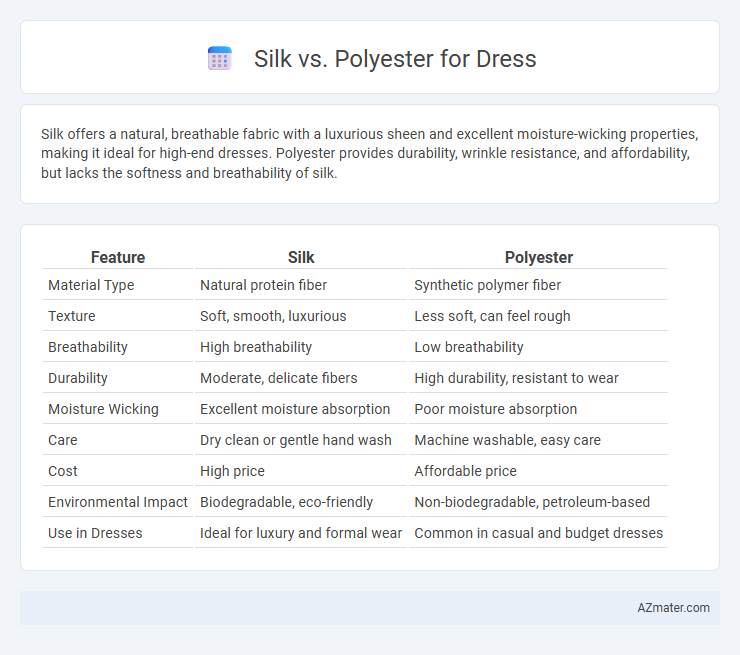Silk offers a natural, breathable fabric with a luxurious sheen and excellent moisture-wicking properties, making it ideal for high-end dresses. Polyester provides durability, wrinkle resistance, and affordability, but lacks the softness and breathability of silk.
Table of Comparison
| Feature | Silk | Polyester |
|---|---|---|
| Material Type | Natural protein fiber | Synthetic polymer fiber |
| Texture | Soft, smooth, luxurious | Less soft, can feel rough |
| Breathability | High breathability | Low breathability |
| Durability | Moderate, delicate fibers | High durability, resistant to wear |
| Moisture Wicking | Excellent moisture absorption | Poor moisture absorption |
| Care | Dry clean or gentle hand wash | Machine washable, easy care |
| Cost | High price | Affordable price |
| Environmental Impact | Biodegradable, eco-friendly | Non-biodegradable, petroleum-based |
| Use in Dresses | Ideal for luxury and formal wear | Common in casual and budget dresses |
Introduction: Silk vs Polyester for Dresses
Silk dresses offer unmatched luxury with natural breathability, softness, and a lustrous sheen that enhances elegance for formal occasions. Polyester dresses provide durability, wrinkle resistance, and affordability, making them ideal for everyday wear and easy maintenance. The choice between silk and polyester influences comfort, appearance, and care requirements in dress selection.
Fabric Overview: What is Silk?
Silk is a natural protein fiber produced by silkworms during the cocoon-spinning process, prized for its smooth texture and luxurious sheen. This fabric excels in breathability and moisture-wicking properties, making it ideal for elegant dresses that offer comfort and sophistication. Compared to polyester, silk provides superior temperature regulation and a more environmentally friendly production process.
Fabric Overview: What is Polyester?
Polyester is a synthetic fiber derived from petroleum-based products, known for its durability, wrinkle resistance, and affordability. Unlike natural fibers like silk, polyester fabric is moisture-wicking, quick-drying, and maintains vibrant colors after multiple washes. Its versatility and low maintenance make polyester a popular choice for everyday dresses, offering an economical alternative to luxury fabrics.
Texture and Feel: Comfort Comparison
Silk offers a smooth, luxurious texture that feels soft and breathable against the skin, making it ideal for comfortable dresswear. Polyester, while less breathable, provides a slightly stiffer texture with a synthetic feel that can trap heat and moisture, reducing overall comfort. The natural fibers of silk excel in moisture-wicking and temperature regulation, enhancing the comfort of dresses compared to polyester's man-made composition.
Appearance: Shine, Drape, and Elegance
Silk offers a natural, lustrous shine that enhances the dress's elegance, creating a sophisticated and luxurious look. Its smooth texture allows for a graceful drape that contours the body softly, elevating the garment's overall fluidity. Polyester, while capable of mimicking silk's sheen, tends to produce a higher-gloss finish that can appear less refined and lacks the authentic depth and softness characteristic of silk.
Breathability and Moisture-Wicking Properties
Silk offers natural breathability and excellent moisture-wicking properties due to its protein fiber structure, allowing air circulation and moisture absorption while keeping the skin dry and comfortable. Polyester, a synthetic fiber, tends to trap heat and moisture, leading to less breathability and potential discomfort during prolonged wear. For dresses prioritizing comfort in warm or humid conditions, silk is generally preferred over polyester for its superior ventilation and moisture management.
Durability and Longevity
Silk offers a luxurious texture but is delicate and prone to damage from abrasion, sunlight, and moisture, resulting in lower durability and reduced longevity compared to synthetic fabrics. Polyester excels in durability due to its resistance to stretching, shrinking, and daily wear, making it a longer-lasting option for dresses. Choosing polyester ensures a dress maintains its shape and color over time, while silk requires careful maintenance to preserve its delicate fibers.
Care and Maintenance Requirements
Silk dresses require gentle care, including hand washing with mild detergent or dry cleaning to preserve their natural fibers and sheen, while avoiding exposure to direct sunlight and harsh chemicals. Polyester dresses are more durable and wrinkle-resistant, allowing for machine washing on a gentle cycle and easier stain removal without significant damage. Proper storage in a cool, dry place is essential for both fabrics to maintain their appearance and longevity.
Sustainability and Environmental Impact
Silk, a natural protein fiber produced by silkworms, offers a biodegradable and renewable alternative to synthetic polyester, which is derived from petroleum and contributes significantly to microplastic pollution. The environmental impact of silk is lower in terms of carbon footprint and chemical use, although traditional sericulture can involve water and pesticide concerns. Polyester manufacturing relies heavily on fossil fuels and generates toxic waste, posing long-term sustainability challenges compared to the more eco-friendly biodegradability and resource efficiency of silk.
Price Considerations and Value for Money
Silk dresses typically come at a higher price point due to the natural fibers and labor-intensive production process, offering luxury, breathability, and a distinctive sheen that many find worth the investment. Polyester dresses are more affordable and widely available, providing durability, wrinkle resistance, and easier maintenance, making them a practical choice for budget-conscious shoppers. When considering value for money, silk offers premium quality and comfort but polyester excels in cost-effectiveness and versatility for everyday wear.

Infographic: Silk vs Polyester for Dress
 azmater.com
azmater.com